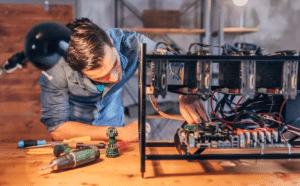Cryptocurrency mining is an essential aspect of the blockchain technology that allows for the creation of new digital currencies. This process involves using computer hardware to solve complex mathematical equations and validate transactions on the blockchain network. In this article, we will delve into the basics of cryptocurrency mining, including how it works, the equipment needed, and the types of mining.
What is Cryptocurrency Mining?
Cryptocurrency mining is the process of verifying transactions on a blockchain network by solving mathematical equations using computer hardware. In essence, it involves solving complex algorithms to verify transactions and add new blocks to the blockchain. This process is essential to the creation of new cryptocurrencies and the validation of transactions on the network.

How Cryptocurrency Mining Works
The mining process involves a network of computers that are connected to the blockchain network. These computers work together to solve complex mathematical equations and validate transactions on the network. The first computer to solve the equation and validate the transaction is rewarded with a new block of cryptocurrency.
Mining Equipment
To mine cryptocurrencies, one needs specialized equipment designed for this purpose. The equipment includes mining hardware, such as graphics processing units (GPUs), application-specific integrated circuits (ASICs), and central processing units (CPUs). Additionally, miners require cooling systems and power supply units to keep their equipment running efficiently.
Types of Cryptocurrency Mining
There are various types of cryptocurrency mining, including proof of work (PoW), proof of stake (PoS), and hybrid consensus algorithms. PoW mining involves solving complex mathematical equations to validate transactions and create new blocks. In contrast, PoS mining involves holding a certain amount of cryptocurrency to validate transactions on the network.
Mining Pools
Cryptocurrency mining can be a challenging and time-consuming process, requiring significant computing power and resources. For this reason, many miners join mining pools to combine their computing power and increase their chances of mining new blocks. Mining pools allow miners to work together and share the rewards of mining.
Risks of Cryptocurrency Mining
While cryptocurrency mining can be a profitable venture, it also comes with risks. These risks include the volatility of cryptocurrency prices, the high cost of mining equipment, and the increasing competition for mining rewards. Additionally, mining can consume a lot of energy, leading to high electricity bills.
Conclusion
Cryptocurrency mining is an essential process in the creation of new digital currencies and the validation of transactions on the blockchain network. It involves solving complex mathematical equations using specialized hardware and validating transactions on the network. While it can be a profitable venture, it also comes with risks, including high equipment costs, volatility of cryptocurrency prices, and energy consumption.
FAQs
- What is the purpose of cryptocurrency mining?
- The purpose of cryptocurrency mining is to validate transactions on the blockchain network and create new digital currencies.
- What equipment is needed for cryptocurrency mining?
- Miners require specialized hardware such as graphics processing units (GPUs), application-specific integrated circuits (ASICs), and central processing units (CPUs).
- Can anyone mine cryptocurrencies?
- Yes, anyone can mine cryptocurrencies, provided they have the required equipment and technical knowledge.
- What are the risks of cryptocurrency mining?
- Risks of cryptocurrency mining include the volatility of cryptocurrency prices, high equipment costs, and energy consumption.
- What is a mining pool?
- A mining pool is a group of miners who work together to combine their computing power and increase their chances of mining new blocks.